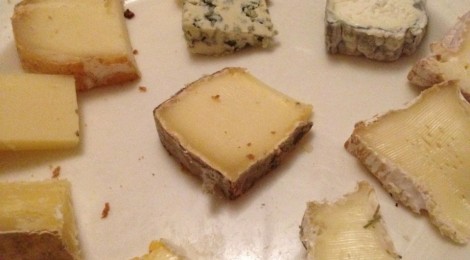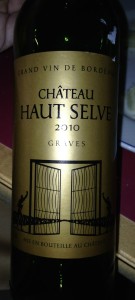
At the Mouth of the Cheese Cave: Baud et Millet
If we have a transcendent experience at one cave, shouldn’t we expect a transcendent experience at the next?
What if the next cave is a cheese cave?
At two in the afternoon the door to Baud et Millet is open. Step right in.
This cave is nearly empty: one person present. My guess is that he’s the head chef or the owner or both.
He’s not all that happy to see us (At 2 P.M. he should be prepping for dinner, not seeing to the needs of wandering Americans!), but he is also conscious of his cave’s reputation.
He won’t cook any food now, but he is willing to craft us a cheese plate and sell us a split of wine. Mid way back in this cave is a staircase lettered in seven languages: “Cheese Cave.”
He disappears down the stairs. He returns with two plates—ten different cheeses in all—a basket of bread, and a little bottle of wine that maintains its dignity despite its diminutive size.
He gives no introduction, no instruction, just cheese. Explore.
To my eye there are:
- Four soft-rind cheeses
- One luminously pale sheep/goat cheese
- Four firm-rind cheeses
- One blue cheese
Get yourself to France. Enter the cheese cave. Lay down your cash and explore.
The most extraordinary cheese in the lot—and all had some level of extraordinary—was a firm rind cheese whose flesh, especially the rind, had the strongest nut essence of any cheese I’ve put to nose or tongue. The inner reaches where almond-like while the outer edge was walnut all the way. The cheese bore no flecks of actual nut, mind you. Either the natural process had given this wondrous and strong flavor, or the cheese had been washed in some kind of a nut solution. I’m betting on Mother Nature. Boggling.
That luminously pale goat cheese? It was luminous from divine intervention. I am convinced that somewhere near Bordeaux there are farmers who know Greek gods personally. The framers use their acquaintance to acquire nectar and ambrosia, and then feed these heavenly foods to their goats (or sheep) before milking. The cheese had a light, herby flavor touched with a tang that seemed like citrus zest. Again, there were no flecks of herb or citrus in the cheese, no evidence of outside intervention. The cheese just floated across you tongue like a cloud, the tang lasting long after the cheese and bread were committed to the cave of your stomach.

A grand wine indeed! Chateau Haut Selve, 2010. 50% Merlot, 50% Cabernet Sauvignon. You can find this in the U.S. for $15-20/bottle. Good value.
I had an excellent surprise in my next-to-last bite. One of the breads—there were four kind in the basket; remember that bread is important to the French—had a few pale and moist raisins wandering in the dough. I combined my last bite of the blue cheese with the raisin-laced bread. My mouth soared over the moon! It was a creamy, not a crumbly blue, and it seemed to wrap itself around the fruit, roll flavor to the back of my mouth, and amplify the sunny richness of the raisin, turning the flavor of the sultana into something like a ruby port. Lingering, lingering, lingering…warm and lasting like summer.
The wine was sublime—50% Cabernet Sauvignon, 50% Merlot—with rich fruit and a silky texture that wanted every complexity the cheese could offer.
I have some lingering sadness that neither our budget nor our timing allowed us to sample the gastronomic excesses that got Baud et Millet its renoun: one is an evening-long meal of eight cheese-based dishes, the other is flat fee cheese orgy where a customer is let loose with a knife in the lower reaches of the cheese cave. It’s all the cheese you can eat of all the types that catch your fancy!
In a luxury of lipids,
Chris
I am so enjoying reading about your travel and culinary experiences! What a wonderful trip you are having!